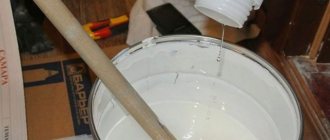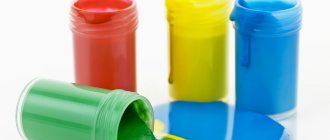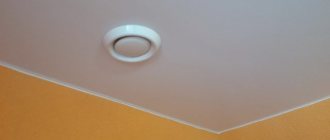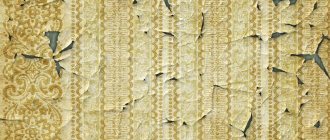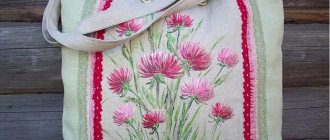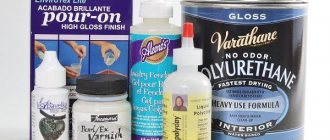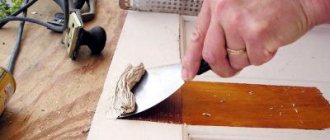The term “dyeing agent” implies the possibility of coloring any substrate. # storage of fibers, coloring of food products (edible pastes, butter, etc.) all colored chemicals can be called dyes; however, there are no universal dyes yet; some are suitable for some purposes, others for others. For example, carrot carotene can color food products, but it is not suitable for storing textile fibers. Nevertheless, when we talk about dyeing any substrate, we mean color stability, i.e. resistant to certain strength tests. Thus, taking into account the practical side of the issue, the concept of “coloring matter”, which by its nature is capable of being stably preserved on the substrate. Ideally, we want the painted item to retain its original color for as long as it lasts.
II. Organic dyes
For the production of colored plastics and rubber, organic dyes of two classes are used - organic pigments and soluble dyes.
The domestic nomenclature of organic dyes does not always reflect their chemical structure. Often in the name of a dye, only its color is indicated and a letter characterizing the shade is given (“Zh” - “yellowish”, “Z” - “greenish”, “C” - “blueish”), the intensification of the shade is indicated by a number, for example 2K, 4Zh.
Polymer materials can be painted with organic dyes in various colors that have brightness and purity of tone. High coloring power allows the introduction of organic dyes into polymer materials in small quantities (0.01-0.1%) which do not cause changes in the mechanical or electrical properties of the finished products.
Why do plants produce dyes?
Pigments give color to a plant cell. They are organic compounds that are necessary for photosynthesis.
Each cell contains a vacuole. It performs a number of important functions. It can accumulate water, nutrients, plant pigments and enzymes. The vacuole is the source of valuable fats, proteins and carbohydrates in the plant, which are necessary for development and growth.
Classification of dyes by types of chemical compounds allows us to distinguish the following groups:
- Alicyclic, including carotenoids. They give yellow and red colors to fruits and flowers.
- Aromatic ones are found in henna leaves and walnut peels.
- Nitrogen-containing heterocycles produce indigo and purple colors.
- Heterocyclic dyes include flavonoids and anthocyanidins.
The shade of the resulting dye depends on the time of collection, the method of extraction, the age of the plant and even the composition of the soil.
Acid dyes
These are typical basic dyes which, when sulfonated, form acid dyes. Phenazines themselves are colorless, but their quaternary salts are quite intensely colored. Azine dye technology was developed between 1880 and 1900. through the efforts of Witt, Caro, Straube, Herp and others.
As a result of these works, eurodin and safranin (N-alkyl- and phenyl derivatives of phenazines), as well as more complex indulines and nigrosines, appeared. The chemical structure of these dyes was clarified much later, in the 20s of our century, thanks to the research of Kermann, but the technology itself has not undergone significant changes since the time of the discoverers, with the exception of some new dyes obtained already in the 1900s. Until now, many of these dyes have important technical and commercial significance. Suffice it to say that in the USA the production of nigrosin alone, used for printing inks, typewriter ribbons, shoe polishes, etc., reaches 4 thousand tons per year. —The structure of the simplest bright red safranin dye, safranin B, is shown by the formula.
This dye (1878) was preceded by safranin T. Due to their low light fastness, these, like other safranins, are not now used for dyeing fabrics, but are sometimes used for dyeing paper.
Technically important azine dyes of a more complex composition (the structure of many have not been definitively established) include indulines and nigrosines, the modification of which produces dyes suitable for dyeing fabrics, wood, the production of inks, varnishes, creams, etc.
Diazines also include a group of black aniline dyes obtained directly on the substrate (cotton, fur) by oxidation of various anilines with dichromate, chlorate or hydrogen peroxide. This is the chemistry of diazine dyes in brief.
Fuchsin and trephenylmethane dyes. In the historic year of the discovery of mauvais, fuchsin was synthesized by Tananson and then by other chemists. It appeared on the market in 1859 under the name Magenta - in memory of the French victory over the Austrians at the Battle of Magenta.
Fuchsin is a representative of a large group of triphenylmethane dyes, among which there are acid, basic, mordant and solvent dyes. They are distinguished by the purity and brightness of their colors, although durability, including light fastness, often leaves much to be desired. The structure of triphenylmethane dyes corresponds to the general formula, where, depending on the substituents (the number and position of amino and hydroxy groups), three rows of dyes are outlined, covering almost the entire color gamut:
- a) violet Deubner series: X=H, Y=MH2, y'=NH2, Z=H; malachite green: X=H, Y=M(CH3)2, Y'=M(CH3)2. Z=H;
- b) fuchsin series: X=Y=MH2, y=NH2, Z=H, CH3;
- c) aurin series (rosolic acid): X=U=OH| Y'=0, Z=H.
Of these three, the fuchsin dyes were obtained much earlier than the others. The first representative of the Deubner violet series, malachite green, was discovered by O. Fischer only in 1877. Fuchsin itself, taking into account the method of its preparation (co-oxidation of aniline and toluidines), is a mixture of compounds, the ophthalmic components of which are pararosanilip (Z=H) and rosaniline (Z=CH3). These components can be obtained in pure form by special synthesis.
Features of pigment substances of inorganic origin
As a result of research, it was revealed that the main characteristic of such pigments, affecting other indicators, is its structural feature. In addition to their structure, pigments differ in the following properties:
Chemical
They directly depend on the composition, which in turn is practically not pure and, as a rule, contains several elements. For example, lead white has the ability to quickly deteriorate even if it is exposed to rather weak acids, while white titanium dioxide, on the contrary, is very stable and will require highly concentrated sulfuric acid to destroy it. To change various characteristics and give them specificity, the composition of inorganic pigments is changed by adding various impurities - these can be magnesium, calcium, silicon, as well as a number of other surfactants.
Crystalline
These properties are due to the fact that the pigment particles are crystals that have their own geometric shape and characteristic features. For example, the anisotropic qualities of pigments are caused by the optical, magnetic, thermal and electrical properties of such crystals, as well as their strength and the rate at which they grow. Both isomorphism and polymorphism depend on the crystalline state. During synthesis, it is possible to add special substances that ensure a certain crystallization of pigment particles.
Optical
Direct dependence on the color of the pigment substance affects the color and protective properties of paints and varnishes. For example, if the coating is white, then it does not heat up, reflecting the incident rays.
Density indicators
Directly depend on the crystallization of particles and can have significant differences. So, for red lead, one of the “heaviest” pigments, it is 8,600 kg/m3, and for “light” azure - 1,920 kg/m3. The mass fraction of the material being manufactured depends on the density of the pigment. There is also bulk density, which shows the occupied mass of pigment, and bulk volume, which, accordingly, characterizes the occupied volume.
Hardness indicators
At high hardness levels, more effort is required to grind. This property also affects the physical and mechanical properties of paints and varnishes. Thus, when using iron oxide pigment, paints and varnishes are characterized by increased abrasiveness.
Features of the type
There are cubic, needle-shaped, spherical, granular, scaly, lamellar forms, depending on how the pigment was obtained and what kind of processing was carried out. Affects the characteristics of weather resistance, hiding power and oil absorption of pigment substances. Scaly and needle pigments have the most optimal set of characteristics.
Dispersion
Characterizes how crushed the particles are; this property increases in proportion to their grinding, while the specific surface area increases. There are monodisperse powders, in which particles are only one size, and a polydisperse version of the powder - it contains different particles. Dispersity characterizes the optical and protective properties of a paint coating. At maximum grinding, which is usually carried out using jet mills, the pigment is called micronized or micro-milled.
Basic and mordant dyes
In all triphenylmethane dyes, the chromophore is the paraquinoid benzene ring, circled in the formula by a dotted line. The dyes of the first two rows are basic in their method of application, the last row are mordant.
Further research in the fuchsin series was aimed at changing the properties of dyes in order to expand the scope of their application (obtaining new shades, the possibility of dyeing wool). This was achieved by introducing alkyl groups at the nitrogen atoms (Laut violet, crystal violet) and sulfonation.
Fuchsin sulfonation was carried out
- Hoffmann (1858),
- Girard and De Leer (1861)
- Nicholson (1862).
The first acid dye in this series was aniline blue (trisulfonic acid N, N', N" - triphenylfuchsine).
Many sulfo derivatives were obtained in other series, which led to the production of acid dyes of green, blue (in the Deubner violet series) and violet (in the magenta series) colors. By using N-ethyl-N-benzylaniline in the synthesis of trphenylmethane dyes, valuable acid dyes of violet, blue and green colors were obtained. The light resistance of triphinylmethane dyes can be improved by introducing indole or pyrazolone residues into the molecule (1932). Dyes are also known that contain, in contrast to phenyl, other (for example, naphthyl) aromatic residues. In the aurin series, dyes containing a salicylic acid residue are of greatest interest. These include chromoxanes, which, when treated with chromium salts on fabric, form durable colors.
Quinoline blue and polymethine dyes. Quinoline blue (Williams cyanine, 1856) is the first representative of cyanine dyes belonging to the class of polymethine dyes containing ethylene bonds. In the 80s. chylolyl red (Jacobsen, 1882) and ethyl red (Hoogenforff and Van Doors, 1883) were obtained.
All these dyes, despite their bright colors, were of no interest to silicon due to low light fastness and instability to acids. Interest in them arose much later, when Vogel discovered the ability of quinoline blue to increase the sensitivity (sensitize) of photographic emulsions with silver halide to red-orange rays. It was further found that ethyl red and panacyanol from the same group of cyanines increase the sensitivity of silver bromide in the zones of 520-570 nm and 570-660 nm, respectively. Research prompted by Vogel's experiments continued to develop as many other cyanines were discovered to be capable of sensitizing photographic emulsions.
Chemistry of cyanines
Thanks to the research of Keoig, Fischer, Kaufman, Mils, Homer, Brooker, Man, Van Dormel, Nies, Japanese authors Funzi, Tahakashi, as well as the work of Soviet chemists Babichev, Levkoev, Kip-Priyanov, Sveshnikov and others in recent decades, the chemistry of cyanines has received brilliant results. development both in theoretical and practical aspects. There are now compounds that sensitize to all regions of the spectrum, including the infrared region, making color and infrared photography possible, which previously seemed quite difficult.
The structure of cyanines contains a polymethine chain with nitrogen atoms at the ends, which are included in the same or different heterocycles.
Here n = 0 or an even number, the dotted line indicates heterocyclic rings. One of the nitrogen atoms carries a positive charge and is an electron acceptor. Thus, through a system of conjugated double bonds, a donor-acceptor interaction with another donor nitrogen atom occurs.
Polymethine dyes include merocyanines, hemicyanines and styryl dyes. From the practical side, astrafloxin FF, an indole-based hemicyanine, astrazones used for dyeing acetate lye, and styryl dyes used as disperse dyes are of interest.
Some cyanines have anthelmintic activity, as well as bactericidal and chemotherapeutic properties. Certain cyanines have found application in laser technology.
This is the brief history of methane dyes, which does not end there if you think about their important role in modern technology.
Aniline yellow and azo dyes.
The first azo dye (n-aminoazobenzene aniline yellow or n-phenylazoanion) was first obtained by Mene in 1861. But the diazotization reaction itself, which made it possible to obtain azo dyes, was discovered in 1858 by Gries, whom we have the right to consider the great father of this most extensive class of dyes . The number of azo dyes registered in Color Jndex is over 2000, while there are no more than 600 anthraquinone dyes, 180 triphenylmethane dyes and about 120 indigoid dyes along with 350 dyes of other classes. This significant representation is primarily due to the wide variety of azo components - diazotized amines of azo components, primarily naphthalene derivatives. Since their introduction, azo dyes have always been technically important, modern, competitive and extremely versatile.
General rules for collecting and preparing dye plants
To obtain and use the dye, you can prepare the raw materials yourself. The following recommendations must be followed:
- Collection and preparations are done in dry, warm weather.
- Raw materials are hung or placed on a pallet as thinly as possible.
- The juice is made from freshly harvested crops.
- Flowers that are in bloom but not wilted are collected.
- The roots are harvested in spring or autumn.
- The stems and leaves are collected before the flowers open.
- The fruits are harvested after they are fully ripe.
Plants are collected both wild and grown independently at the dacha.
Azo dyes
Azo dyes include acid, basic, direct, mordant, fiber dyes, disperse dyes, pigments, and solvent dyes. The chromophore in azo dyes is the azo group -N=N-. Many azo dyes contain several azo groups (disazo dyes, trisazo dyes, polyazo dyes). Azo dyes, perhaps more than others, sometimes have fantastic names, which is often associated with advertising aspects.
One of my friends and colleagues, a specialist in the synthesis of azo dyes, who, like a magician, entertained them. invention, telling me the truth and lies about azo dyes, he often asked: “Tell me, don’t you think that these names - eriochrome, supranol, chloranthine, sirius, chloramine - carry something enchanting and make you remember myths and fairy tales with gnomes and nymphs that we were told as children? He had enough reason to say so, since he was a good chemist, a knowledgeable colorist, and partly a poet.
After aniline yellow, Bismarck brown was discovered - the first disazo dye (1863), then chrysoidine (1875) aniline - m - phenylenediamine (a conventional verbal designation for azo dyes, in which the arrow goes in the direction from the diazotized amine to the azo component), yellow for solvents 2 and some basic dyes. During the period 1870-1880. A “boom” of azo dyes begins, along the long path of development of which there were some surprises.
Basic (cationic) azo dyes
Basic (cationic) azo dyes, although used quite widely, are not very numerous; many of them have moderate strength ratings. Along with them, azophenylsafranins are of some interest. For polyacrylnitroyl (PAN) dyeing, basic azo dyes containing a quaternary nitrogen atom play an important role. The most common names for these dyes are basacryls, astrazones and maxillons.
Since 1875, acidic azo dyes based on phenols and naphthols with carboxyl or sulfo groups began to appear.
One of the first sulfonic azo dyes, orange 2 (8), was obtained in 1876, at the same time the first water-soluble disazo dye, Biebrich scarlet, was synthesized. Sulfo-free phenol-based azo dyes, such as sudans, are used as pigments or as solvent dyes.
The most important intermediates for the synthesis of acidic azo dyes are naphthylamines, naphthols, sulfonated aminonaphthols, among which chromotropic acid and azo-acid are of greatest importance. Based on these acids, a large number of technically important disazo dyes are obtained. As an example, let us give the structure of a blue-black dye based on al-acid.
With the discovery of tartrazine, azo dyes were replenished with a group of azo-pyrazolone dyes, which were produced in different countries under the names supranols, supramines, polars, rosanthrenes, etc.
Since 1880, mordant azo dyes have appeared, which are complex salts (varnishes) of the original acid dyes. Usually, chromium salts, less often honey, aluminum, nickel, and cobalt are used as mordants. Mordant dyes are quite numerous, their technology has constantly developed, and they still play an important role in textile dyeing today.
The first mordant azo dyes were obtained in 1878 based on salicylic acid. In the 90s, mordant dyes appeared containing an hydroxy group in the orto position to the azo group, among which the most interesting are O, O'-dioxyazo dyes. Then metal-containing mordant dyes (neolans, palatines) appeared, which relieved dyers of the need to etch the fabric. Dyeing with them is carried out as with ordinary acid dyes. Later, in 1919, 1:1 metal complex azo dyes were released, and in 1951, 1:2 metal complexes (), which give particularly even and durable colors. The general structure of these dyes is shown by formulas.
In 1884, Boettiger discovered that sodium salt of Congo red directly dyed cotton from a water-salt solution. Many other benzidine-based dyes had the same properties. Thus, direct dyes (substantial) were discovered and intensive research in this area began.
Dyes based on I-acid
Further work led to the appearance of dyes based on N-acid (16, the asterisk in the figure shows the position of the entering azo group), stilbene derivatives, etc.
From 1870 to 1890, water-insoluble azo dyes (pigments, azooid dyes such as aniline - (b-naphthol) were obtained (Tripke, 1877). The subsequent discovery of red steam became the beginning of the wider use of azo dyes, forming colors directly on the fiber (impregnation of cotton with an alkaline solution of naphthol followed by treatment with a solution of diazotized amine). Subsequently, the group of dyes developed on the fiber was replenished with yellow pigments based on acetoacetarylides, capable of combining at the methylene group (Ar-NH-CO-CH2-CO-CH3), as well as 2-hydroxy arylides -3-naphthoic acid All these azo components for the formation of dyes on fiber are sold under the common (incorrect) name of naphthols.
Azo dyes developed on fiber are widely used for printing patterned colors. To facilitate the use of these dyes, chemists have developed more convenient forms, including stable diazotized amines (diasols, diazotates, diazomines, diazosulfonates), as well as complete dye formulations containing both components of the azo coupling, which react when treated appropriately on the fiber (rapids, rapidogens, rapidozoles).
In conclusion of this section, it is impossible not to note once again the enormous technical significance of azo dyes and the associated high level of their technology, which has gone from wooden vats with manual stirring to continuous, modern technological schemes with automated control.
Red and blue dye
The coloring substances of red and blue plants are due to the presence of pigments hematoxylin, indican, etc. They are extracted from the following plants:
- Vaida. Used for dyeing textiles. The plant has been known since the times of Ancient Egypt. Deep blue dyes are obtained from it.
- Indigofera. Indigofera tinctifera is native to India. It contains substances that give an indigo tint.
- Garmala. The red color is extracted from harmala seeds. The plant is grown in Central Asia.
- Moraine. A dye made from moraine roots gives a bright shade.
To obtain red color, pomegranate, privet, mallow, etc. can be used.
Classification
It is generally accepted to classify dyes according to chemical characteristics, i.e. by the generality of chloroform systems, which is convenient for those who produce and study them, or by their area of application. In most cases, the source for obtaining natural food dyes is vegetable raw materials.
Obtaining natural food dyes from a variety of plant materials containing pigments whose color is determined by such chemical compounds as anthocyanins, carotenoids, chlorophyll, etc. To expand production and increase the production of red food dyes concentrated from the marc of dark grape varieties, blackcurrant and chokeberry, and dyes obtained from non-standard tea raw materials. The manufacturing technology of the first three indicated dyes has been mastered by industry. Red food coloring is produced from the marc of dark grape varieties. The quality of the beetroot-tea dye also gives grounds to conclude that it is promising. It is more resistant to the influence of environmental reactions compared to other anthocyanin dyes and when sealed in racks for storage. It is a fine powder, contains a small amount of moisture and is easy to transport to places of consumption. Can be used in various branches of the food industry for coloring products.
The technology for producing dye from crowberries was developed mainly in laboratory conditions. The quality of the dye allows it to be used for coloring confectionery and other food products with an acidic environment. Provided the collection of wild crowberries is organized, the possibility of introducing dye manufacturing technology into industry is beyond doubt.
Use of inorganic pigments
Their main use is in the paint and varnish industry. In addition to the above-mentioned ability to impart optical and decorative properties to paints and varnishes, inorganic pigments regulate insulating, anti-corrosion and a number of other indicators.
With their help it is possible to obtain various special coatings:
- heat resistant,
- anti-fouling,
- electrically insulating,
- antifriction,
- fireproof,
- glowing in the dark.
All paints and varnishes that use pigments are directly dependent on the presence of a pigmented substance in them. The differences in structures are easily explained by how the pigment particles and the polymer phase of paints and varnishes interact with each other. By introducing pigment particles you can influence various qualities of coatings, for example:
- curing speed
- elasticity, wear resistance and strength
- water absorption
- water permeability
For information, when using pigments, the protective properties of the coating increase, the adhesive strength also increases, and anodic processes, on the contrary, decrease.
All this is due to the different characteristics of pigments. Based on them, a classification was made according to the following indicators:
- color
- appointment
- mode of production
- chemical composition.
However, it is a fairly common situation when one group contains pigments with different characteristics, so it should be borne in mind that the division is very arbitrary, and these substances are usually divided based on the following characteristics:
- chemical composition, it analyzes the amount of salts, elements and oxides.
- color color: there are chromatic or colored and achromatic pigments, only with gray, white and black shades.
2.3. Characteristics of individual dyes and their use
Natural food colors must meet the following basic requirements.
The most important of them is the absolute harmlessness of dyes intended for coloring food products. Therefore, natural food colors must be made from plant materials approved by health authorities in order to obtain harmless coloring substances from them. In addition to harmless coloring pigments, natural food dyes contain valuable biologically active components - vitamins, carbohydrates, mineral salts.
Natural food dyes must be resistant to t influences. When heated to 1000-105oC, the basic properties should not change. Typically, the stability of natural food colors is determined by heating their solutions to a boil and boiling for 5 minutes.
Natural food colors must have good coloring power. When we paint food products with them, they must have intense, clearly defined colors of appropriate tones.
Natural food colors should not have an unpleasant permanent taste or odor. Typically, these dyes have a taste and smell corresponding to the taste characteristics of the plant material from which they are obtained. The taste of most natural food dyes, the basis of which are anthocyanins, is sour, because Food acids are used in their production. The presence of bitter taste in dyes is not allowed.
Natural food colors can be produced in either concentrated liquid or dry powder form.
The color of colored natural food dyes must be stable and not change during storage during the warranty period.
As experiments have shown, the introduction of the listed additives into the primary extract helps to increase the content of coloring substances in the concentrated dye. The best results were obtained by adding 1.5-2% molasses to the primary extract. In this case, almost no precipitation was observed during the concentration of the extract; the enyl content in the eno dye increased, which made it possible to significantly reduce the evaporation rate of the primary extract.
According to organoleptic indications, the encoding dye must satisfy the following requirements: in appearance it is an intensely colored liquid of a dark garnet color. Presence of sediment and turbidity is not allowed. The taste of the dye is characteristic, sour. The smell is faintly wine-like.
Green coloring matter of plant leaves
The green plant tint is used in the food and cosmetic industries. Chlorophyll is a complex organic compound with the participation of which photosynthesis occurs. It can be found in various crops.
Green color comes from leaves:
- hemp;
- sorrel;
- nettle;
- marsh horsetail.
The green coloring matter of plant leaves, chlorophyll, is extracted by mordant from iron sulfate. Green shades are also obtained by mixing several dyes.
Reactons and dremarens
This was followed by reactons and dremarens (1959), levafixes E, elysians, reactnas, etc. Following the dyes for cotton, active dyes for wool and polyamide were released - procylans, dremarens (1970), etc.
Based on the nature of their interaction with the substrate, active dyes can be divided into two groups: with the first, the substrate interacts by nucleophilic substitution, with the second by nucleophilic addition. The first type includes procion dyes (45); the second type includes remazols, which under dyeing conditions form a vinyl group that attaches an ionized cellulose residue (Cel –O-) to the double bond. In the case of wool, the nucleophilic reaction occurs due to the terminal NH2 groups of the protein polymer, and the dye binds to the substrate through an NH bridge.
Currently, a variety of reactive groups used in active dyes are known, including those containing a mobile halogen atom in the aliphatic part, for example COCH2Hal. In turn, the colored part can belong to a dye of any class: azo dye, including metal-containing dye, anthraquinone dye, phthalocyanine dye, etc.
Classes of dyes - organic dyes. Chemical dyes, both active and dispersed, have undergone enormous chemical and technological evolution. \The selection and organization of production of natural food dyes for coloring a variety of food products is currently very relevant.
Lecture. 9. Specialty chemicals
Methyl violet (methylene violet) is a powder with a green metallic luster. Solutions in water and ethyl alcohol are purple in color.
Neutral red is a dark green crystalline powder. The aqueous solution is red in color. The solution in ethyl alcohol is red, slightly luminescent in crimson-red color.
Nile Blue is a green crystalline powder with a bronze luster. Poorly soluble in cold water, solubility increases when heated. Soluble in ethyl alcohol. The solutions are colored blue.
Basic fuchsin is dark green shiny crystals. The contact surface is painted pink. Soluble in water (preferably when heated), soluble in ethyl alcohol. The solutions are pink in color.
Basic Blue K is a blue powder. The contact surface is painted blue. Soluble in water and ethyl alcohol. The solutions are blue in color.
Basic, Brown 2K - black-brown powder. Solutions in water and ethyl alcohol are brown in color.
Azur 1 (methylenazur) - dark brown crystals with a greenish sheen. Soluble in water, soluble in methyl and ethyl alcohol. The solutions are blue in color. Alcohol solutions have bluish-red luminescence.
Brilliant Yellow is a light brown powder. Solutions in water and ethyl alcohol are yellow-orange in color.
Eosin is a yellowish-orange crystalline powder. Insoluble in water and benzene; Poorly soluble in ethyl alcohol, highly soluble in alkalis. The resulting solutions are pink in color.
Luminescent substances are chemical substances that have the ability to luminesce (glow) in ultraviolet rays.
When illuminated, some substances have the ability to not only reflect part of the light falling on them, but also begin to glow themselves, especially under the influence of sources emitting ultraviolet light.
The phenomenon of cold glow of some chemical substances with a strictly defined color when illuminated by ultraviolet rays is called photoluminescence (a combination of the Greek word “photos” - light and the Latin word “luminescence” - glow). According to Stokes' rule, luminescence light is characterized by a longer wavelength than the exciting light. Therefore, when a substance is illuminated, it can luminesce with a color specific to it.
Noteworthy is the fact that some substances retain the ability to glow for a certain time after the lighting has stopped (residual afterglow). This type of photoluminescence is called phosphorescence. The glow that stops when the light is illuminated is called fluorescence. However, it is difficult to draw a sharp boundary between them and this division is to a certain extent arbitrary.
The phenomenon of luminescence is used for luminescent analysis. The luminescent substances used in OVD operation are, as a rule, colorless or slightly colored. In addition, powdered luminescent substances are finely dispersed and have good adhesive properties. Thanks to this, they are widely used when conducting operational-search activities for the hidden marking of any objects. The phenomenon of luminescence makes it possible to detect the presence of negligible amounts of luminescent substances. For example, it is enough to have a millionth of a gram of a luminous substance in the form of a solution in order to detect it by its characteristic luminescence.
The main representatives of luminescent substances used in internal affairs bodies have the following properties:
The light composition of BZS is a fine-crystalline white powder. Insoluble in water and other solvents. In ultraviolet rays, the light composition of the BZS has a bright blue luminescence. This substance is used to apply marks to fabric, yarn, and fur.
The light composition of FK-102 is a yellow-orange fine-crystalline powder. Insoluble in water and other solvents. In ultraviolet rays it has orange-red luminescence. Used for marking fabric, fur, yarn.
Lumogen yellow-green is an amorphous substance of yellow-green color. Dissolves in organic solvents such as toluene, dichloroethane, gasoline. In ultraviolet rays it has yellow-green luminescence.
Lumogen water blue is a pale blue powder. It dissolves well in toluene, gasoline, and dichloroethane. In ultraviolet rays it has blue luminescence.
Lumogen light green is a finely crystalline powder of light green color. Dissolves in toluene, gasoline, dichloroethane. In ultraviolet rays it has green luminescence.
Straight white is a white powdery substance. In ultraviolet rays it has blue luminescence.
Rivanol is a yellow, fine-crystalline powder. It dissolves poorly in water, but well in alcohol. In ultraviolet rays it has yellow luminescence.
Tetracycline is a yellow powder. Poorly soluble in water. In ultraviolet rays it has yellow luminescence.
Triphenylpyrazoline is a white powder. Soluble in alcohol. In ultraviolet rays it has blue luminescence.
It should be noted that of all the listed luminescent substances, rivanol, tetracycline and triphenylpyrazoline are medications. This makes it possible to use them for labeling food products, because in the quantities used, even if they enter the human body, they do not cause harm to health. In addition, these substances do not affect the taste and nutritional properties of the labeled products.
Indicators are chemical substances that change their color when exposed to certain chemical reagents. They are used to mark objects that are invisible under normal conditions, but easily detectable due to color changes.
In the work of the internal affairs department, medications are used as indicators. These substances are harmless to humans and the environment. Drug-based indicators are easy to manufacture and convenient for covert labeling and subsequent detection (manifestation). It is also taken into account that the probability of accidental contact of pharmaceuticals with the surface of the marked item is very small.
One of the representatives of this group of substances is phenolphthalein.
Phenolphthalein is a fine-grained white powder. It dissolves poorly in water, but well in alcohol. Phenolphthalein solution is colorless and transparent. When a solution with an alkaline reaction is added to it (for example, ammonia solution, soda, etc.), it acquires a bright crimson color. It is precisely this property that is used when conducting operational search activities.
Other pharmaceutical preparations can be used as indicators, for example, salicylic acid, antipyrine, amidopyrine, resercinol, calcium gluconate, analgin; to develop records and marks produced by solutions of these substances, a 3% aqueous solution of ferric chloride (III) is used.
Salicylic acid is small, odorless, white needle-shaped crystals that sublimes when heated gently (transitions into a gaseous state, bypassing the liquid state). Salicylic acid is poorly soluble in water, but easily dissolves in ethyl alcohol and diethyl ether. The resulting solutions are colorless. When developed with a 3% FeCl3 solution, they acquire a violet color.
Antipyrine - colorless crystals or white crystalline powder, odorless, slightly bitter taste. Easily soluble in water and ethyl alcohol. The resulting solutions are colorless. When exposed to a FeCl3 solution, they acquire a brown color.
Amidopyrine - white crystals or white powder, odorless, slightly bitter taste. Soluble in water and ethyl alcohol. The resulting solutions are colorless. When exposed to a FeCl3 solution, they acquire a pink color with a brown tint.
Resorcinol is a white or white with a slight yellowish tint crystalline powder with a specific odor. Under the influence of air and light it gradually turns pink. Easily soluble in water and ethyl alcohol. The resulting solutions are colorless. When exposed to a FeCl3 solution, they acquire a pink color with a brown tint.
Calcium gluconate is a white, granular, crystalline powder, odorless and tasteless. Insoluble in ethyl alcohol. Let's dissolve in water. The resulting solution is colorless. When exposed to a solution, FeCl3 acquires a greenish-yellow color.
Analgin is a completely white or slightly yellowish crystalline powder, odorless and bitter taste. Let's dissolve in water. The resulting solution is colorless. When exposed to a solution, FeCl3 turns pink with a crimson tint. Since analgin quickly decomposes in the presence of moisture, its aqueous solution turns yellow during storage. To mark objects, only freshly prepared solution should be used.
The listed indicators are medical preparations, which allows them to be effectively used not only for labeling various items, but also food products.
When using pharmaceuticals to prepare indicator solutions, you can take ready-made dosage forms containing the starting substances or ready-made solutions of the proposed pharmaceuticals,
Odorants are special chemicals, the main property of which is a characteristic, persistent odor that is easily detected by a specially trained dog. These substances are, as a rule, little common natural chemical compounds that have a specific effect on the dog’s sense of smell and central nervous system. Odor preparations facilitate the work of service-search dogs during various operational activities.
The following scent preparations are in service with the internal affairs bodies: US (trace enhancer) and SP-80 ms.
The drug US is a specially prepared powdery substance. Its smell is well recognized by dogs in the temperature range from -20°C to + 30°C. Traces of the drug on clothes, shoes, and household items are easily detected by the dog within 3-7 days. Ordinary service-search dogs that have undergone short special training are suitable for sampling objects with traces of the US. US can be used in conjunction with coloring and luminescent substances.
The drug SP-80 ms is an oily, viscous, brown substance with a characteristic odor, slightly soluble in water, harmless to humans and animals. The drug consists of a fat base and a special odorous substance. Luminescent substances have been added to it. In some cases it is used without the addition of the latter. This variety is called SP-80.
The smell of the drug in various climatic conditions persists on marked objects (terrains) for up to 10 days. The drug is resistant to sunlight, rain, wind, and air temperature fluctuations.
The presence of its traces can be perceived by dogs of any breed (service-search, hunting, decorative), which have developed a complex of conditioned reflexes to this drug. To maintain the reflex, only 2-3 workouts per month are required.
The use of odorous substances involves creating conditions that ensure their transfer to the offender’s shoes. This allows not only to successfully follow up on the trail, but also to select individuals suspected of committing a crime. Marking various material assets with a scent substance makes it possible to effectively detect them and select marked objects from a number of homogeneous ones. The combination of odorous substances with coloring and luminescent substances mutually increases the effectiveness of their use, since it makes it possible to detect the corresponding traces for a long time.
§ 2. Main directions of use of special chemicals
CHS are used both for marking various objects during operational activities, and for equipping chemical traps installed at objects where theft is possible or occurs.
In operational-search activities, special chemicals are used in the form of powders, special ointments, solutions, special pencils, and aerosols.
The type of chemical storage equipment and its state of aggregation are selected based on the current operational situation.
In this case, the nature, color of the item and the conditions of its storage are taken into account. Before applying marks to objects, it is necessary to first test chemicals on samples similar to the material used, and only after obtaining positive results, begin applying marks.
Powdered chemical substances are used both separately and in mixture with each other. They are used for marking various objects with a fleecy or rough surface, as well as for equipping devices that ensure their spraying. As a rule, these are mixtures of coloring and luminescent substances.
CXV powders are applied with a brush or by pouring them into objects or their models. Replacement of items treated with powdered dry chemicals should be done depending on local climatic conditions, but at least once a year when the mixture is sealed, and once a quarter - if there is no sealing, since dry chemical powders easily absorb moisture from the air, which deteriorates their properties.
Special ointments are a fatty base into which coloring, luminescent substances or mixtures thereof are introduced. Vacuum grease, Vaseline, grease, constalin, etc. are used as a base. When preparing special lubricants, it is necessary to take into account the properties of the fat base. Thus, ointment based on petroleum jelly can be used in the temperature range from - 3 ° C (with a further decrease in temperature it hardens) to + 25 ° C (with a further increase in temperature the ointment easily liquefies).
Special lubricants based on constalin and vacuum lubricant are more resistant to fluctuations in temperature and humidity. Special lubricant based on vacuum lubricant has high stickiness and limited solubility. Even after removing it with gasoline, traces of luminescent substances can be detected by a characteristic glow in ultraviolet rays.
A special lubricant prepared on the basis of vacuum grease and petroleum jelly (3:1 weight ratio) has proven itself well. It adheres to any smooth surfaces and does not change its consistency in the temperature range from -20°C to +30°C.
Special ointments are applied to objects or their packaging. Unlike powdered chemicals, they adhere well to various smooth surfaces. It should also be taken into account that the fat base insulates the dry substance from contact with air moisture. This ensures the safety of marks for a longer time, even in conditions of high humidity. Thus, if items treated with powdered chemicals without sealing should be replaced at least once a quarter, then when applying special ointment - at least once a year. Fragrance substances prepared in the form of an ointment are easily absorbed by wool, cotton and other fabrics, and are well retained on various surfaces (wood, metal, plastic, concrete, rubber, leather, dirt and asphalt roads). In addition, coloring and luminescent additives are well preserved from direct exposure to external factors, such as humidity and temperature.
Special ointments are applied using a brush or cotton swab.
SCS solutions are prepared on the basis of luminescent substances or indicators and are used to mark various objects. When preparing solutions, water or organic solvents can be used, for example, alcohol, ether, toluene, dichloroethane, acetone. If necessary, SCS can be injected directly into the liquids that need to be labeled. For example, by adding luminescent substances to ordinary blue or violet ink, you can get so-called special ink. They can be used to mark various documents with a fountain pen. If it is necessary to obtain a solution that is well fixed on the surface of any object, dichloroethane can be used as a solvent, into which plexiglass shavings are introduced to form a film that is difficult to wash off when dry. SCS solutions are applied to objects using a brush, pen, or spray bottle.
Special luminescent pencils are used to apply marks to various objects, documents, and banknotes. Outwardly no different from ordinary pencils, these pencils contain a special additive in their core mass - a luminescent substance. Pencils are available in several colors.
Before applying marks, you must make sure that the marked objects themselves do not luminesce in ultraviolet rays. The color of the pencil is selected according to the color of the surface of the object. When applying marks to thin sheets of paper, documents, and paper packaging of goods, you must ensure that no pressed marks remain on them. In these cases, an object with a hard, smooth surface, such as glass or plexiglass, should be placed under the objects to be marked.
Marks made with special luminescent pencils are preserved for a long time.
Aerosol sprayers are a container filled with a mixture of a solution of a luminescent substance or indicator with freons. When a sprayer is used, a stream of mixture is ejected from a cylinder under the pressure of freon vapor and, breaking up into tiny droplets, forms an aerosol cloud.
Using aerosol sprays, you can quickly and efficiently process large surfaces of objects, spending a small amount of dry chemicals. The following luminescent aerosols are in service with the internal affairs bodies: “Madizol-M”, “Madizol-PP”, “Madizol-SZh”.
"Madizol-PP" is used for marking food products.
"Madizol-M" is used for applying marks to fur and wool products, cotton and synthetic fabrics.
"Madizol-SZh" is intended for marking building materials, leather, glass, ceramics, plastic, and fur of farm animals.
Phenosol is produced based on phenolphthalein Phenosol aerosol packaging may have a metering valve. Phenosol is used to mark alcohol-containing liquids. The presence of phenosol is detected using an alkaline solution.
Thus, the police department has in its inventory a sufficient number of special chemicals that can be effectively used in the fight against crime. However, this gives a positive result only if their traces are quickly discovered during operational search operations.
§ 3. Concept and types of chemical traps
The problem of petty theft has existed since ancient times and will probably always exist, since increasing one’s financial status in an easily accessible way is, to a greater or lesser extent, characteristic of every person. Today, technical means of security, surveillance and alarm have enormous capabilities, but they cannot protect the personal property of citizens from encroachment by dishonest people. Since it is impossible to create a society with a network of total video control and surveillance, other methods of solving the problem are used.
One of the methods that helps prevent and quickly solve property crimes is the use of various chemical and technical means. These include special chemical compounds, which in practice and in the literature are often called chemical traps or marker agents (some scientists propose the term “forensic markers”). Such substances, when they get on the clothes or body of a criminal, leave difficult to remove and clearly visible traces, which makes it possible to establish his illegal entry into the premises, contact with certain objects, sources of stolen materials and channels of their distribution, giving a bribe, etc. The use of special means in the fight against crime is provided for by the law on police (clause 9 of article 11), in which they are called “special coloring agents”2.
Order of the Ministry of Internal Affairs of the Russian Federation dated September 11, 1993 No. 423 gives the following interpretation of the concept of a chemical trap: these are devices or devices equipped (treated) with special chemicals (coloring or odor), camouflaged as various objects, with the help of which such substances are transferred to the body and person's clothes.
Chemical traps are one of the means of solving crimes. They meet all the requirements for technical means, and therefore are legal and their use should not raise doubts. The idea of creating traps was suggested by practice itself. Criminal investigation officers are well aware of the facts when solving thefts was greatly facilitated if the criminal, at the time of committing the crime, accidentally stained his hands, shoes or clothes with oil paint, whitewash or other dyes. Such facts were considered a great success, since it unmasked the criminal among others and contributed to his quick arrest. The development and use of chemical traps turns success into a pattern, since trap preparations, when they come into contact with a person’s body and his clothing, cause the appearance of brightly colored and difficult to wash off traces that are easily noticeable to others, which contributes to the apprehension of the criminal. Investigators do not use chemical traps on their own, but they often encounter them when investigating bribery, as well as thefts from retail outlets, utility and warehouse premises, pharmacies, and from office desks in institutions. Substances were ejected from the devices at the violator when he attempted to unauthorizedly open or take the equipped item. In this case, abundant staining occurred, and the specific property of the dye - to penetrate the pores of the body or the structure of clothing and shoes - made it possible to recognize the intruder for a very long time. Even if visible traces of dye were washed away, they showed up very clearly in ultraviolet rays.
The composition of the substances used includes base mixtures with additives. They are equipped with dyes of several colors or a combination of them, which allows them to be used to mark a product of a certain type or a specific territory. If a person is detained who has come into contact with a chemical trap, his involvement in a specific crime can be unmistakably established, even if the thief keeps silent about it or denies it altogether. Often, with the help of traps, the thief can be identified before the theft itself is discovered.
Chemical traps, operating autonomously, do not require power supply or additional equipment during installation and operation, and in combination with a security alarm they provide an even greater effect, especially when the thief commits a theft in a “jerk”.
Along with providing assistance in protecting material assets at retail facilities, bases, warehouses and utility rooms, there is often a need to protect the personal property of a particular person. Given the high technical level of modern life, very few means are used for the prevention, documentation and detection, in hot pursuit, of already committed thefts of personal property, which are often committed by employees sitting next to each other. The reason is not that there are no such means - the principle of rationality and expediency simply comes into force due to their high cost. At the same time, both psychological trauma and material damage to the victim are relegated to the background. Chemical traps only act on a “thief” or a “curious” employee.
Due to the fact that there is a great variety of theft of personal property, chemical traps are made structurally close to items of interest to the thief. Materials and covers that are located at the place where the chemical trap is installed are used: in exchange offices, banks and their branches, post offices, bank bags with appropriate inscriptions are used, in shops and kiosks there are special boxes that can create the illusion that they contain money, workplaces - wallets and handbags, etc.
Developers and manufacturers of chemical traps try to fulfill the requests and wishes of customers. Due to the increased number of thefts from dachas and cellars, a thief deterrent device using tear gas has been successfully used. Having penetrated the structure and moved around it, the thief will certainly hook a thin nylon fishing line, which, through a spring mechanism, opens the valve of the container with tear gas. Even if the room is large, it will become impossible to stay in it. This device operates in almost any climatic conditions, is completely energy independent, and does not require maintenance, but it must be installed in closed, poorly ventilated rooms.
Due to the recent widespread spread of this type of crime, such as theft of non-ferrous metals in industrial equipment, a chemical trap with a spring mechanism for releasing dye was successfully tested. The principle of its operation is that the spring mechanism is triggered when the equipment is opened or removed without permission. At the same time, a portion of the dye is thrown at the offender. The trap retains its operating properties for several years even in extreme climatic operating conditions, which is the first requirement for such devices. It is used to prevent, and in the event of theft from a locked object, to quickly resolve the theft.
A spring-loaded dye ejection trap is installed in electrical and communication boxes, fire hydrant boxes, and is especially suitable for protecting payphone equipment - aluminum-clad telephone booths and new payphones, which are often attacked by non-ferrous metal hunters. During the manufacturing process, all problematic issues that arise during the operation of such devices are taken into account.
As practice has shown, after a chemical trap is triggered, regardless of whether the thief is revealed, information about the fact of the use of such devices destroys the desire to steal for a long time.
Chemical traps are divided into two groups according to their purpose:
1) for marking;
2) to block objects with material assets. The following traps are currently produced for marking money, securities, and various items (for example, those transferred as a bribe):
1. Set of reagents and devices “Rhododendron” - designed for applying marks to banknotes.
2. A special product in aerosol packaging “Firefly” - intended for applying to banknotes, documents and other objects a thin layer of a luminescent substance that has increased adhesion (in Latin “sticking”) to the human skin and is invisible under normal conditions . When the fingers of the hands on which the drug is in contact with various surfaces (door handle, etc.), fingerprints remain, visible under the influence of ultraviolet radiation with a wavelength of 365 nm. The surface area treated from one aerosol package is 1.5 m2. For these purposes, the coloring composition “Fudge” is also used (Fig. 1), made by mixing special dyes with certain types of lubricants. Upon contact with it, difficult to wash off, oily crimson stains remain on hands and clothes.
3. Special product “Disco”; is a cosmetic roller containing a transparent gel with a special luminescent marker, invisible under normal lighting, which allows you to confirm the legitimacy of a visitor to public events without presenting a pass (Fig. 2). The corresponding invisible mark is applied by the controller to the visitor's hand by rolling the dispenser ball. The presence of the marker can be detected by a blue luminescent glow when irradiated with ultraviolet light at a wavelength of 365 nm.
4. Marking felt-tip pens “M” and “K”; are intended for applying marks and inscriptions to various objects and documents in order to identify them or exclude counterfeiting. Markers of the “M” brand are used for marking paper materials, brand “K” are used for marking objects made of metals, plastics, leather, fabrics, etc. In ultraviolet rays, markers “M” give a blue glow, “K” - green.
5. Luminescent markers in the form of wax pencils (crayons); are intended for applying marks that are invisible under normal lighting (Fig. 3). They mark various items - packaging boxes, boxes, etc. The authenticity and safety of packaging is checked under ultraviolet light with a wavelength of 365 nm by the characteristic multi-colored glow. The complete set consists of 5 crayons of different colors: yellow, green, yellow-green, blue and red.
6.Luminescent marker “Lak-M”; designed to protect various items in order to detect cases of substitution or unauthorized opening (Fig. 4). The mark is applied to a clean, hard surface. Materials suitable for its application are artificial and natural leather, metals, plastics, wood, etc. The authenticity of the item is judged by the characteristic yellow-green glow of the mark in ultraviolet rays, which appears after the solvent has dried.
Chemical traps designed to block objects with material assets are divided into active and passive.
Active chemical traps have a device for throwing a dye into space and thus ensuring that it gets on the clothing and exposed parts of the body of the person who activated the device. The release of dye can occur both when mechanical devices, such as springs, are triggered, and when a pirote is triggered
⇐ Previous26Next ⇒
Recommended pages:

